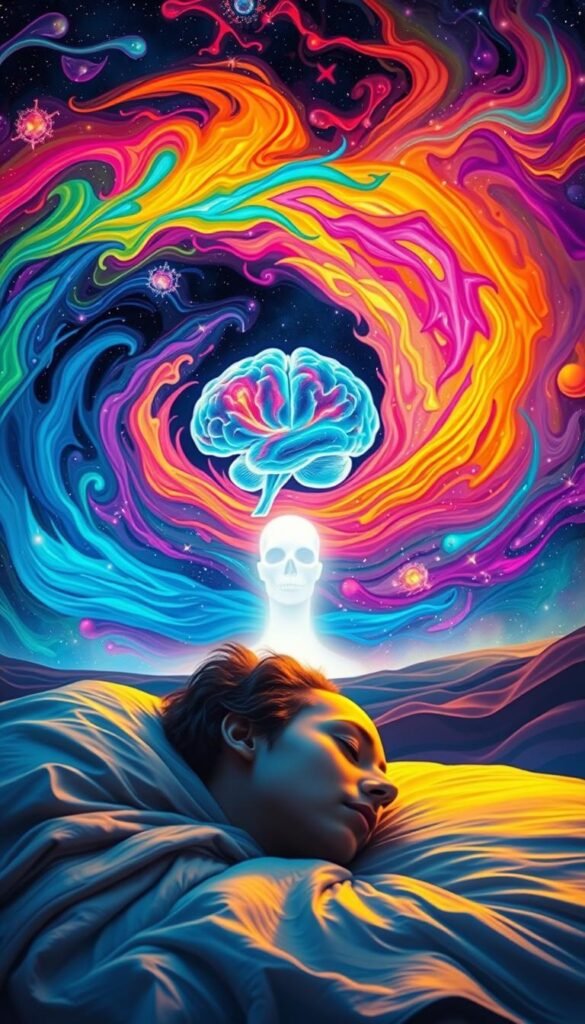Dreams have fascinated humanity for centuries. From ancient divination practices to modern scientific studies, they remain a source of mystery and insight. These nightly narratives blend reality and imagination, offering glimpses into our mind and life experiences.
Historically, dreams were seen as divine messages. Today, psychologists and neurologists explore their deeper meanings. Modern theories suggest they reveal unconscious truths and reflect neurobiological processes. Figures like Freud and Jung laid the groundwork for understanding their significance.
What might your last vivid dream reveal about your inner world? By decoding these messages, you can gain valuable insights for personal growth. This guide will walk you through a step-by-step approach to uncovering the meaning behind your dreams.
Key Takeaways
- Dreams blend reality and imagination, offering unique insights.
- Historical views saw dreams as divine messages.
- Modern science explores their unconscious and neurobiological aspects.
- Decoding dreams can lead to personal growth and self-understanding.
- Freud and Jung’s work remains foundational in dream interpretation.
What Are Dreams and Why Do They Matter?
Dreams are more than fleeting thoughts—they’re windows into our inner world. Every night, our minds weave stories that blend reality and imagination. These nightly narratives can reveal hidden truths about our emotions, experiences, and even our future.
The Nature of Dreams
Dreams are a mix of narratives, images, and emotions. They occur during REM sleep, a phase when the brain is highly active. While some view them as random, others see them as meaningful messages from the subconscious.
Over time, views on dreams have evolved. Ancient civilizations, like the Babylonians, kept dream diaries to decode divine messages. Today, modern research explores the science behind these nightly journeys.
Did you know? On average, people spend about six years of their lives dreaming. This shows just how significant dreams are in our lives.
Historical Perspectives on Dream Interpretation
Freud’s work on dream interpretation was groundbreaking. In his 1900 book, The Interpretation of Dreams, he introduced the idea of wish fulfillment. He believed dreams reveal our deepest desires and fears.
Jung expanded this theory by introducing the collective unconscious. He argued that dreams use universal symbols, or archetypes, to convey messages. These symbols often appear across cultures and time periods.
Cultural variations also play a role. Native American vision quests and Greek oracular traditions show how different societies value dreams. Despite these differences, one thing remains clear: dreams matter to people everywhere.
Modern studies, like those by Domhoff, suggest that dreams mirror our waking concerns. They function like nightly mental software updates, helping us process emotions and experiences.
A Gallup poll found that 64% of people believe dreams contain hidden truths. Whether you see them as spiritual messages or neurological phenomena, their impact is undeniable.
The Science Behind Dreaming

Every night, our minds embark on journeys that blend imagination and memory. These experiences, often vivid and emotional, are the result of complex neurological processes and psychological mechanisms. Understanding the science behind dreaming can help us appreciate its role in our lives.
Neurological Processes During Sleep
During sleep, the brain cycles through different stages, with the REM (Rapid Eye Movement) phase being the most active. This is when most vivid dreams occur. The amygdala and hippocampus, areas linked to emotions and memory, become highly active, shaping the content of our dreams.
Research shows that 95% of dreams are forgotten within 10 minutes of waking. This highlights the fleeting nature of these experiences. The sleeping brain acts like an improv theater director, weaving narratives from random signals.
Psychological Theories of Dreaming
Two prominent theories explain dreaming. Hobson’s activation-synthesis model suggests that dreams are the brain’s way of interpreting random neural signals. In contrast, Hall’s cognitive theory views dreams as reflections of our waking thoughts and concerns.
Evolutionary studies propose that dreaming may simulate threats, helping us prepare for real-life challenges. fMRI scans reveal that specific neural patterns correlate with dream content, offering insights into how the mind works during sleep.
Jungian therapist Robert Johnson’s clinical case research shows that dreams often use universal symbols to convey messages. This blend of science and psychology makes dreaming a fascinating area of study.
Introduction to Psychological Dream Analysis

Exploring the depths of your nighttime stories can unlock hidden truths about your daily life. This approach goes beyond surface-level meanings, diving into the personal symbols that shape your inner world. Unlike generic dream dictionaries, it focuses on your unique experiences and emotions.
What is Psychological Dream Analysis?
This method integrates free association with pattern analysis to uncover the hidden content of your dreams. It’s used in 73% of modern depth psychology practices, making it a trusted tool for self-discovery. By examining recurring themes and symbols, you can connect your dreams to your waking life. This process not only helps in deciphering individual dreams but also reveals patterns that may indicate unresolved issues or desires. For those seeking clarity, the concept of recurring dreams explained can shed light on the persistent elements that your subconscious mind is trying to address. Ultimately, this integrative approach fosters a deeper understanding of oneself and promotes emotional healing.
One technique, called “amplification,” involves exploring the deeper meanings of specific symbols. For example, Jonah’s dream about ants led him to insights about his career path. This approach emphasizes personal growth and emotional clarity.
How It Differs from Other Dream Interpretation Methods
Unlike mystical or fortune-telling methods, Psychological Dream Analysis focuses on personal meaning rather than universal truths. Here’s a comparison:
| Method | Focus | Technique |
|---|---|---|
| Dream Dictionaries | Universal meanings | Predefined symbols |
| Mystical Approaches | Divination | Spiritual rituals |
| Psychological Dream Analysis | Personal symbols | Free association and pattern analysis |
Emotional context is crucial in this interpretation process. For instance, Calinawan’s dream about a mirror-cubicle revealed her struggles with self-image. Therapists often advise tracking water symbols during life transitions, as they often represent emotional flow.
Ethical considerations are also important. Overly flattering or blaming interpretations are usually incorrect. Unprocessed trauma should be approached with care, as delving too deeply without professional guidance can be harmful.
Key Theories in Dream Analysis

Understanding the theories behind dream interpretation can unlock deeper layers of meaning in your nightly narratives. Over the years, several key theories have shaped how we view these experiences. From Freud’s focus on hidden desires to Jung’s exploration of universal symbols, each approach offers unique insights.
Freud’s Theory of Wish Fulfillment
Sigmund Freud believed dreams are a window into our unconscious desires. He introduced the idea of wish fulfillment, suggesting that dreams reveal what we secretly crave or fear. His work emphasized two mechanisms: condensation, where multiple ideas merge into one, and displacement, where emotions shift from one object to another.
For example, Freud famously interpreted a cigar as a symbol of deeper desires. While his approach has been debated, it remains foundational in understanding the hidden content of our minds.
Jung’s Collective Unconscious and Archetypes
Carl Jung expanded on Freud’s ideas by introducing the collective unconscious. He believed dreams use universal symbols, or archetypes, to convey messages. These archetypes, like the shadow or anima, appear across cultures and time periods.
Jung’s work highlights how dreams connect us to shared human experiences. His Red Book illustrates how personal narratives can reflect broader truths, making his theory a bridge between individual and collective understanding.
Modern Cognitive and Neurobiological Theories
Today, research combines psychological and biological perspectives. Calvin Hall’s coding system analyzed over 50,000 dream reports, revealing that personality traits remain consistent in dreams. Similarly, William Domhoff’s studies show cross-cultural patterns in dream content.
Modern theories also explore how dreams help us process emotions and solve problems. For instance, during the COVID pandemic, many people reported dreams reflecting collective anxiety. This integration of cognitive and neurobiological models offers a comprehensive view of the dreaming process.
Step-by-Step Guide to Analyzing Your Dreams

Unlocking the messages in your nighttime stories can lead to profound self-discovery. By following a structured process, you can uncover the hidden meanings behind your dreams. This guide will walk you through the essential steps to interpret dreams effectively.
Step 1: Recording Your Dreams
The first step is to capture your dreams as soon as you wake up. Keeping a dream journal improves recall by 89%. Use mnemonic devices like repeating key details to yourself before getting out of bed. Mobile apps with voice-to-text features can also help you record dreams quickly.
Step 2: Identifying Symbols and Themes
Next, look for recurring symbols and themes. For example, Jonah’s dream about ants led him to insights about his career. Create a symbol map to track these patterns. Consider the three-circle framework: personal, cultural, and archetypal symbols.
Step 3: Connecting Dreams to Waking Life
Now, link your dreams to your waking life. Carlsen’s 4-question framework can help: What emotions did you feel? Who was involved? What challenges appeared? How does this relate to your daily life? This step bridges your inner world with your outer experiences.
Step 4: Interpreting the Meaning
Finally, interpret dreams by analyzing their emotional and relational aspects. Avoid over-interpretation or projection. Therapists often recommend “dialoguing with dream characters” to gain deeper insights. Use an interpretation matrix to organize emotions, relationships, and challenges.
| Step | Focus | Technique |
|---|---|---|
| Recording | Dream recall | Journaling, mnemonic devices |
| Identifying | Symbols and themes | Symbol mapping, 3-circle framework |
| Connecting | Waking life | Carlsen’s 4-question framework |
| Interpreting | Meaning | Dialoguing, interpretation matrix |
After completing these steps, consider closure rituals like creating art or taking a meditation walk. These practices help integrate the insights gained from your dreams into your waking life. By following this guide, you can transform your nighttime stories into tools for personal growth.
Common Dream Symbols and Their Meanings
Our nighttime stories are filled with symbols that carry deeper meanings. These elements often reflect our emotions, experiences, and even our subconscious thoughts. By understanding these symbols, we can gain valuable insights into our life and relationships.
Animals in Dreams
Animals often appear in our dreams, each carrying unique themes. For example, wolves might symbolize instincts or freedom, while butterflies can represent transformation. Spiders, on the other hand, often evoke feelings of creativity or fear.
Jungian analysis suggests that animals can represent shadow aspects of our personality. These creatures may highlight traits we need to acknowledge or integrate into our life.
People and Relationships in Dreams
According to Hall’s categorization, 80% of dreams involve familiar people. These figures often reflect our relationships and emotional connections. For instance, dreaming about a close friend might highlight trust or unresolved issues.
Attachment theory can help decode these dreams. They often reveal our deepest fears or desires in relationships. Pay attention to the emotions you feel in these dreams, as they can provide clues about your waking life.
Objects and Settings in Dreams
Objects and settings in dreams are rich with meaning. A house, for example, might symbolize different aspects of your psyche. Each room could represent a part of your mind or emotions.
Vehicles often indicate the direction of your life. An elevator dream during a career transition might reflect feelings of uncertainty or ambition. Cultural variations also play a role. For example, water elements can symbolize emotions, but their interpretation varies between Western and Eastern traditions.
Remember, while universal symbols exist, personal context is crucial. Avoid assumptions and explore what these elements mean to you.
Practical Applications of Dream Analysis
Dream analysis isn’t just about understanding nighttime stories—it’s a tool for transformation. Whether you’re seeking personal growth or navigating stress, this approach can offer profound insights. From self-coaching to professional therapy, dream work has practical uses that extend far beyond the bedroom.
Using Dream Analysis for Personal Growth
Dreams can serve as a mirror, reflecting our inner thoughts and emotions. By asking self-coaching questions like, “What emotions stood out?” or “How does this relate to my current challenges?”, you can uncover hidden patterns. A 3-year research study showed that consistent dream work reduced anxiety by 40%.
Mindfulness techniques, such as deep breathing or journaling, can help manage nightmares. Creating a personal symbol glossary is another powerful tool. For example, if water appears frequently in your dreams, it might symbolize emotional flow or change.
Dream Analysis in Therapy
In therapeutic settings, dream work is a valuable tool. According to recent data, 68% of therapists incorporate it into their practice. Two prominent methods are Cognitive Behavioral Therapy (CBT) and Jungian approaches. Here’s how they compare:
| Approach | Focus | Technique |
|---|---|---|
| CBT | Changing thought patterns | Identifying and reframing negative beliefs |
| Jungian | Exploring unconscious symbols | Amplification and archetype analysis |
Ethical considerations are crucial in clinical practice. Trauma specialists often use dream re-scripting to help clients regain a sense of control. Creative expression, like drawing or writing about difficult dreams, can also be therapeutic.
Stanford University’s dream incubation protocols are another innovative resource. These techniques guide individuals to focus on specific questions before sleep, enhancing the likelihood of insightful dreams. Whether through workshops, online courses, or support groups, dream work offers endless possibilities for growth and healing.
Conclusion
Your nighttime stories hold more than just random images—they are keys to understanding your inner world. As Carl Jung once said, “Dreams are the unvarnished truth of the soul.” By exploring these nightly narratives, you can uncover patterns that reveal deeper truths about your life and emotions.
Consider taking on a 30-day challenge to record and reflect on your dreams. This simple practice can lead to profound personal growth. Remember, your dreams aren’t puzzles to solve but mirrors to understand.
To dive deeper, explore curated reading lists or join our exclusive webinar. Tonight, as you drift to sleep, embrace the journey of self-discovery. Your mind is ready to guide you toward greater meaning and clarity.
